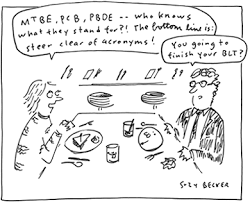
Every industry has its acronyms. For the non-technical person, acronyms confuse you. For the individual knowledgeable in the industry, acronyms are used to hide behind. Rather than illuminating, you obfuscate.
That’s not good, and it’s not what you want. Limit your acronym use. Write them fully out AND explain them (if at all possible) in clear, plain language the first time you use them. In follow-up references, limit their use and substitute other common phrases when appropriate.
For example, when describing the BAHWTT, if you stated that up front, people would think it’s a newly democratized African nation. If you were in the environmental field, you might instead say it stands for Best Available Hazardous Waste Treatment Technology. If you’re a communicator, rather than BAHWTT, you could say “cleanup technology” or “environmental treatment system” or even a “waste minimizer.” The point is, you can use multiple terms to convey what is needed to the reader.
Though many acronym users believe you need to use them regularly to show how smart you are, it’s better to have people understand you. That’s when people start to think you’re a genius.
Next time you need to describe the best technology to clean up hazardous waste, or an EPDS (Electrical Power Distribution System – the power wires going into your home), take some extra time to remember your audience and explain what the acronym really means to others. Otherwise, they’ll be flying blind, and you don’t want someone being their passenger.
That’s not good, and it’s not what you want. Limit your acronym use. Write them fully out AND explain them (if at all possible) in clear, plain language the first time you use them. In follow-up references, limit their use and substitute other common phrases when appropriate.
For example, when describing the BAHWTT, if you stated that up front, people would think it’s a newly democratized African nation. If you were in the environmental field, you might instead say it stands for Best Available Hazardous Waste Treatment Technology. If you’re a communicator, rather than BAHWTT, you could say “cleanup technology” or “environmental treatment system” or even a “waste minimizer.” The point is, you can use multiple terms to convey what is needed to the reader.
Though many acronym users believe you need to use them regularly to show how smart you are, it’s better to have people understand you. That’s when people start to think you’re a genius.
Next time you need to describe the best technology to clean up hazardous waste, or an EPDS (Electrical Power Distribution System – the power wires going into your home), take some extra time to remember your audience and explain what the acronym really means to others. Otherwise, they’ll be flying blind, and you don’t want someone being their passenger.